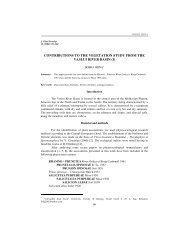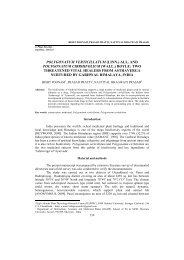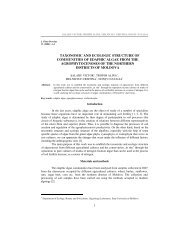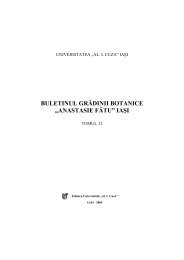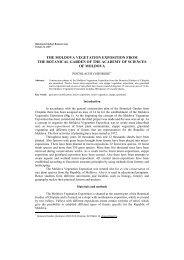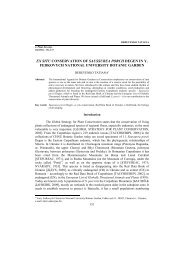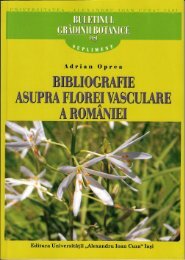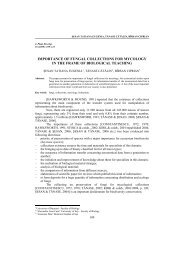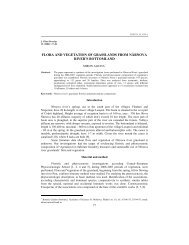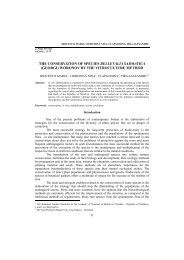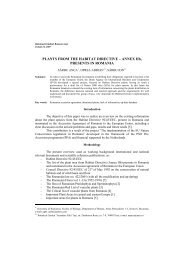trichoderma viride pers. - Journal of Plant Development
trichoderma viride pers. - Journal of Plant Development
trichoderma viride pers. - Journal of Plant Development
Create successful ePaper yourself
Turn your PDF publications into a flip-book with our unique Google optimized e-Paper software.
TRICHODERMA VIRIDE PERS. – EXPERIMENTAL MODEL FOR BIOLOGICAL AND …<br />
1. There were established the optimal biological parameters for the development<br />
<strong>of</strong> T. <strong>viride</strong>, isolate Td 50 : (i) solid culture media: Weindling, Warcup, Malt extract agar,<br />
PDA; (ii) carbon sources: monosaccharides mannite, fructose, ribose, glucose, manose; (iii)<br />
nitrogen sources: peptone, aminoacids DL-leucine, L-cistine, DL-citruline, DL-nor-leucine,<br />
ammonium nitrate and tartrates salts; (iv) pH initial values <strong>of</strong> culture media: 4.0-5.5 (for<br />
growth), 4.0-8.5 (for biomass); (v) temperatures: optimum 26ºC, for growth 24-32ºC, for<br />
sporulation 20-22ºC.<br />
2. The parameters for submerged cultivation <strong>of</strong> T. <strong>viride</strong> are: (i) Weindling<br />
medium, variant Wg containing indigenous food glucose; (ii) Period <strong>of</strong> cultivation – 96<br />
hrs.; (iii) Viability <strong>of</strong> biomass – 6-7 monthes; (iv) Optimal temperature 25ºC; (v) Optimal<br />
pH – 6.0-6.5; (vi) Optimal aeration 0.75-1.25 l air/l medium/ minute, (vii) Viability <strong>of</strong><br />
biomass – 6-7 monthes.<br />
3. It has been done the first step in a future research conducted to obtain a<br />
molecular characterization <strong>of</strong> our collection <strong>of</strong> T. <strong>viride</strong> isolates selected as a biological<br />
control agents <strong>of</strong> some practically important plant pathogens. 3.1. Proteins with MM 7, 8,<br />
10, 12, 14, 35, 56, 60 kD represent characteristics for genus and species, being well<br />
differentiated; 3.2. Within the same species the quantitative differences appeared at the<br />
level <strong>of</strong> proteins with MM <strong>of</strong> 29, 45, 87, 89 kD and are determinated by provenance <strong>of</strong><br />
various isolates belonging to the same species; 3.3. Isolates Td49 and Td50 proved strong<br />
similarities having a common provenance; both isolates proved a high antagonistic capacity<br />
against the test-pathogens studied.<br />
4. The antagonistic ability <strong>of</strong> tested T. <strong>viride</strong> isolates was different against plant<br />
pathogens; the most active was Td 35 , followed the others: Td 35 > Td 49 > Td 50 > Td 45 > Td 5.<br />
5. It has been established and experimentally verified the technological phases for<br />
obtaining plant protection bioproducts based on T. <strong>viride</strong>.<br />
Acknoledgements for the financial support by the research projects: RELANSIN<br />
29 (2000-2002), CEEX 38 (BIOTECH) (2006-2008), CEEX 43 (AGRAL) (2006-2008),<br />
CEEX 75 (AGRAL) (2006-2008).<br />
The paper has been presented at the National Symposium <strong>of</strong> Romanian<br />
Mycological Society (XXI th edition) at Babeş-Bolyai University Cluj-Napoca (2-4<br />
September 2009).<br />
References<br />
1. BAICU T., ŞESAN T. & OANCEA F. 1998. Compoziţii microbiologice pentru tratarea seminţelor pe bază<br />
de Trichoderma sp., brevet de invenţie nr. 113.103 din 31. 03. 1998.<br />
2. BENITEZ T., DELGADO-JARANA J., RINCÓN A.M., REY M. & LIMÓN C.M. 1998. Bi<strong>of</strong>ungicides:<br />
Trichoderma as a biocontrol agent against phytopathogenic fungi, Recent Research <strong>Development</strong>s in<br />
Microbiology, 63: 129-150.<br />
3. BONTEA V. & ŞESAN T. 1980. Contribuţii la studiul biologiei unor ciuperci antagoniste. I. Influenţa<br />
diferitelor medii de cultură şi a surselor de carbon asupra creşterii şi sporulării ciupercii Trichoderma<br />
<strong>viride</strong> Pers. ex Fr., St. şi Cerc. Biol., Biol. Veget., 32 (2): 165-173.<br />
4. BURGES H.D. 2000. Formulation <strong>of</strong> microbial biopesticides. Beneficial microorganisms, nematodes and<br />
seed treatments. Kluwer Academic Publishers Dordrecht / Boston / London: 411 pp.<br />
5. CIURDĂRESCU M., ŞESAN T. E. & OLTEAN E.. 1997. Electrophoretic analysis <strong>of</strong> some Trichoderma<br />
<strong>viride</strong> isolates and mutants, Molecular Approaches in Biological Control, Delémont (Elvetia), 15-18<br />
septembrie 1997; IOBC wprs Bulletin, 21 ( 9): 189-194.<br />
6. COPPING L.G. 1998. The BioPesticide Manual, First Edition, British Crop Protection Council: 333 pp.<br />
60



